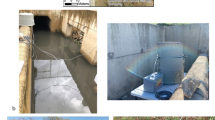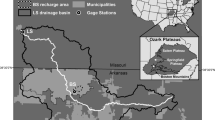Abstract
Three independent microbial source tracking (MST) methods were applied to a small urban subwatershed in Orange County, California. Fifty-seven water samples collected over summer 2002 were analyzed for human adenovirus and enterovirus. Enterococci and E. coli were isolated for antibiotic resistance analysis (ARA) and for PCR identification of human- and animal-specific toxin genes, respectively. All water samples were PCR negative for human enteroviruses and E. coli human-specific toxin gene. E. coli toxin markers revealed the presence of toxin genes specific to bird, rabbit, and cow. Enterococci ARA results supported this conclusion and indicated that fecal bacteria from bird and wild animal feces as well as soil were the predominant source found in the watershed. An E. coli, isolated from the watershed and inoculated back into the heat-sterilized storm drain water, increased 4 log units within 6 days. Collectively, these results suggest that bird and wild animal feces, soil amendments, and/or fecal coliform growth in the storm drain are the major contributors to the fecal bacterial pollution in downstream areas. However, human adenoviruses were detected on two occasions. Fecal bacterial concentrations were not elevated on these two occasions, suggesting that the elevated levels of fecal indicator bacteria in this small watershed could be unrelated to the source of human adenovirus.




Similar content being viewed by others
References
Adams LM, Simmons CP, Rezmann L, Strugnell RA, Robins-Browne RM (1997) Identification and characterization of a K88- and CS31A-like operon of a rabbit enteropathogenic Escherichia coli strain which encodes fimbriae involved in the colonization of rabbit intestine. Infect Immun 65:5222–5230
Anderson MA, Whitlock JE, Harwood VJ (2006) Diversity and distribution of Escherichia coli genotypes and antibiotic resistance phenotypes in feces of humans, cattle, and horses. Appl Environ Microbiol 72:6914–6922
Berry ED, Miller DN (2005) Cattle feedlot soil moisture and manure content: II. Impact on Escherichia coli 0157. J Environ Qual 34:656–663
Blanch AR, Belanche-Munoz L, Bonjoch X, Ebdon J, Gantzer C, Lucena F, Ottoson J, Kourtis C, Iversen A, Kuhn I, Moce L, Muniesa M, Schwartzbrod J, Skraber S, Papageorgiou GT, Taylor H, Wallis J, Jofre J (2006) Integrated analysis of established and novel microbial and chemical methods for microbial source tracking. Appl Environ Microbiol 72:5915–5926
Board SDRWQC (2003) San Diego Regional Water Quality Control Board, Clean-up & Abatement Order 99-211, Quarterly Progress Report, City of Laguna Niguel, County of Orange, Orange County Flood Control District
Chern EC, Tsai YL, Olson BH (2004) Occurrence of genes associated with enterotoxigenic and enterohemorrhagic Escherichia coli in agricultural waste lagoons. Appl Environ Microbiol 70:356–362
Choi S, Jiang SC (2005) Real-time PCR quantification of human adenoviruses in urban rivers indicates genome prevalence but low infectivity. Appl Environ Microbiol 71:7426–7433
Choi S, Chu WP, Brown J, Becker SJ, Harwood VJ, Jiang SC (2003) Application of enterococci antibiotic resistance patterns for contamination source identification at Huntington Beach, California. Mar Pollut Bull 46:748–755
Craun GF, Calderon RL (2006) Workshop summary: estimating waterborne disease risks in the United States. J Water Health 4:241–253
Ebdon JE, Taylor HD (2006) Geographical stability of enterococcal antibiotic resistance profiles in Europe and its implications for the identification of fecal sources. Environ Sci Technol 40:5327–5332
Enriquez CE, Hurst CJ, Gerba CP (1995) Survival of the enteric adenoviruses 40 and 41 in tap, sea, and waste water. Water Res 29:2548–2553
Field KG, Bernhard AE, Brodeur TJ (2003a) Molecular approaches to microbiological monitoring: fecal source detection. Environ Monit Assess 81:313–326
Field KG, Chern EC, Dick LK, Fuhrman J, Griffith J, Holden PA, LaMontagne MG, Olson B, Simonich MT (2003b) A comparative study of culture-independent, library-independent genotypic methods of fecal source tracking. J Water Health 1:181–194
Gaun SK, Xu RL, Chen S, Odumeru J, Gyles C (2002) Development of a procedure for discriminating among Escherichia coli isolates from animal and human sources. Appl Environ Microbiol 68:2690–2698
Gerba CP, Gramos DM, Nwachuku N (2002) Comparative inactivation of enteroviruses and adenovirus 2 by UV light. Appl Environ Microbiol 68:5167–5169
Griffith JF, Weisberg SB, McGee CD (2003) Evaluation of microbial source tracking methods using mixed fecal sources in aqueous test samples. J Water Health 1:141–151
Hagedorn C, Robinson SL, Filtz JR, Grubbs SM, Angier TA, Reneau RB (1999) Determining sources of fecal pollution in a rural Virginia watershed with antibiotic resistance patterns in fecal streptococci. Appl Environ Microbiol 65:5522–5531
Harwood VJ, Whitlock J, Withington V (2000) Classification of antibiotic resistance patterns of indicator bacteria by discriminant analysis: use in predicting the source of fecal contamination in subtropical waters. Appl Environ Microbiol 66:3698–3704
Ishii S, Ksoll WB, Hicks RE, Sadowsky MJ (2006) Presence and growth of naturalized Escherichia coli in temperate soils from lake superior watersheds. Appl Environ Microbiol 72:612–621
Jiang SC, Chu W (2004) PCR detection of pathogenic viruses in southern California urban rivers. J Appl Microbiol 97:17–28
Jiang S, Noble R, Chu W (2001) Human adenoviruses and coliphages in urban runoff-impacted coastal waters of Southern California. Appl Environ Microbiol 67:179–184
Johnson JR, Stell AL (2001) PCR for specific detection of H7 flagellar variant of fliC among extraintestinal pathogenic Escherichia coli. J Clin Microbiol 39:3712–3717
Johnson JR, O’Bryan TT, Low DA, Ling G, Delavari P, Fasching C, Russo TA, Carlino U, Stell AL (2000) Evidence of commonality between canine and human extraintestinal pathogenic Escherichia coli strains that express papG allele III. Infect Immun 68:3327–3336
Khatib LA, Tsai YL, Olson BH (2002) A biomarker for the identification of cattle fecal pollution in water using the LTIIa toxin gene from enterotoxigenic Escherichia coli. Appl Microbiol Biotechnol 59:97–104
Khatib LA, Tsai YL, Olson BH (2003) A biomarker for the identification of swine fecal pollution in water, using the STII toxin gene from enterotoxigenic Escherichia coli. Appl Microbiol Biotechnol 63:231–238
LeJeune JT, Besser TE, Hancock DD (2001) Cattle water troughs as reservoirs of Escherichia coli O157. Appl Environ Microbiol 67:3053–3057
Moore DF, Harwood VJ, Ferguson DM, Lukasik J, Hannah P, Getrich M, Brownell M (2005) Evaluation of antibiotic resistance analysis and ribotyping for identification of faecal pollution sources in an urban watershed. J Appl Microbiol 99:618–628
Noble R, Allen S, Blackwood A, Chu W, Jiang S, Lovelace G, Sobsey M, Stewart J, Wait D (2003) Use of viral pathogens and indicators to differentiate between human and non-human fecal contamination in a microbial source tracking comparison study. J Water Health 1:195–207
Olson BH, Oshiro RK (1997) Occurrence of STh toxin gene in wastewater. In: Kay D, Fricher C (eds) Coliforms and E. coli: problem or solution? The Royal Society of Chemistry, Cambridge
Provence DL, Curtiss R (1994) Isolation and characterization of a gene involved in hemagglutination by an avian pathogenic Escherichia coli strain. Infect Immun 62:1369–1380
Rajkowski KT, Rice EW (1999) Recovery and survival of Escherichia coli O157:H7 in reconditioned pork-processing wastewater. J Food Prot 62:731–734
Scott TM, Rose JB, Jenkins TM, Farrah SR, Lukasik J (2002) Microbial source tracking: current methodology and future directions. Appl Environ Microbiol 68:5796–5803
Simpson JM, Santo-Domingo JW, Reasoner DJ (2002) Microbial source tracking: state of the science. Environ Sci Technol 36:5289–5729
Sinton LW, Finlay RK, Hannah DJ (1998) Distinguishing human from animal faecal contamination in water: a review. N Z J Mar Freshw Res 32:323–348
Stewart JR, Ellender RD, Gooch JA, Jiang S, Myoda SP, Weisberg SB (2003) Recommendations for microbial source tracking: lessons from a methods comparison study. J Water Health 1:225–231
Stoeckel DM, Mathes MV, Hyer KE, Hagedorn C, Kator H, Lukasik J, O’Brien TL, Fenger TW, Samadpour M, Strickler KM, Wiggins BA (2004) Comparison of seven protocols to identify fecal contamination sources using Escherichia coli. Environ Sci Technol 38:6109–6117
Topp E, Welsh M, Tien YC, Dang A, Lazarovits G, Conn K, Zhu H (2003) Strain-dependent variability in growth and survival of Escherichia coli in agricultural soil. FEMS Microbiol Ecol 44:303–308
Tsai YL, Olson BH (1991) Rapid method for direct extraction of DNA from soil and sediments. Appl Environ Microbiol 57:1070–1074
Wiggins BA, Andrews RW, Conway RA, Corr CL, Dobratz EJ, Dougherty DP, Eppard JR, Knupp SR, Limjoco MC, Mettenburg JM, Rinehardt JM, Sonsino J, Torrijos RL, Zimmerman ME (1999) Use of antibiotic resistance analysis to identify nonpoint sources of fecal pollution. Appl Environ Microbiol 65:3483–3486
Acknowledgments
This investigation was supported by a fund from the County of Orange, California. The field sampling effort was supported by Public Facility and Resource Department of County of Orange. Special thanks go to Chris Crompton, Bruce Moore, and Mary Brill at County of Orange for their valuable input on research design and field logistics support; to Nancy Palmer at City of Laguna Niguel for providing background data on the research site and valuable input on the study design; and to Erica Dunbar at UCI for the assistance with growth experiment.
Author information
Authors and Affiliations
Corresponding author
Additional information
Manuscript submitted to Environmental Management, January 3, 2007.
Electronic supplementary material
Below is the link to the electronic supplementary material.
ESM 1
(DOC 75.5 kb)
Rights and permissions
About this article
Cite this article
Jiang, S.C., Chu, W., Olson, B.H. et al. Microbial source tracking in a small southern California urban watershed indicates wild animals and growth as the source of fecal bacteria. Appl Microbiol Biotechnol 76, 927–934 (2007). https://doi.org/10.1007/s00253-007-1047-0
Received:
Revised:
Accepted:
Published:
Issue Date:
DOI: https://doi.org/10.1007/s00253-007-1047-0




